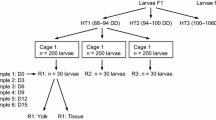Abstract
The increases in constituents per unit weight of eggs during embryonic development of the gastropod Crepidula fornicata amounted to 14.6% for ash, 1.0% for protein, and 0.3% for non-protein nitrogen. During the same stages, fat content decreased from 33.7 to 20.3%, carbohydrate from 10.2 to 7.7% and energy content from 6209 to 5298 cal/g dry organic substance. The cumulative efficiencies for yolk utilization were 83.8% for dry weight, 61.0% for energy, 85.1% for protein, 50.7% for fat, and 63.6% for carbohydrate. A single egg contained 0.0269 cal, a single veliger 0.0164 cal. Of the 0.0105 cal expended on metabolic processes of the embryo, oxidation of fat contributed as much as 65.3%, while that of protein and carbohydrate amounted only to 18.8 and 6.3%, respectively. On the basis of ecophysiological considerations, a new classification of eggs is proposed.
Similar content being viewed by others
Literature cited
Baldwin, E.: An introduction to comparative biochemistry, 4th ed., 179 pp. Cambridge: University Press 1964.
Barnes, H. and M. Barnes: Egg size, nauplius size, and their variation with local, geographical and specific factors in some cirripedes. J. Anim. Ecol. 34, 391–402 (1965).
Brody, S.: Bioenergetics and growth, 1023 pp. New York: Rheinhold 1945.
Chipperfield, P. N. J.: The breeding of Crepidula fornicata in the river Blackwater, Essex. J. mar. biol. Ass. U.K. 30, 49–71 (1951).
Faustov, V. S. and A. I. Zotin: Changes in the heat of combustion of the eggs of fishes and amphibians during development. Dokl. Akad. Nauk SSSR (Biol. Sci.) 162, 320–323 (1964).
Flüchter, J. and T. J. Pandian: Rate and efficiency of yolk utilization in developing eggs of the sole Solea solea. Helgoländer wiss. Meeresunters. 18, 53–60 (1968).
Giese, A. C., L. Greenfield, H. Huang, A. Farmanfarmian, R. Boolootian and R. Lasker: Organic productivity in the reproductive cycle of the purple sea-urchin. Biol. Bull. mar. biol. Lab., Woods Hole 116, 49–58 (1959).
Lasker, R.: Efficiency of yolk utilization by developing embryos and larvae of the Pacific sardine Sardinops caerulea (Giard). J. Fish. Res. Bd Can. 19, 867–875 (1962).
Needham, J.: Biochemistry and morphogenesis, 785 pp. Cambridge: University Press 1950.
Paffenhöfer, G. A. und H. Rosenthal: Trockengewicht und Kaloriengehalt sich entwickelnder Heringseier. Helgoländer wiss. Meeresunters. 18, 45–52 (1968).
Paine, R. T.: Ash and calorie determinations of sponge and opisthobranchs tissues. Ecology 45, 384–387 (1964).
Pandian, T. J.: Preliminary report on chemical composition and caloric content of developing eggs of the shrimp Crangon crangon. In: C. M. (Council Meeting) I.C.E.S. (International Council for the exploration of the sea) Sect. Shellfish Committee K 12, 1–8 (1967a).
—: Changes in chemical composition and caloric content of developing eggs of the shrimp Crangon crangon. Helgoländer wiss. Meeresunters. 16, 216–224 (1967b).
Pandian, T. J.: Physiological studies on the developing eggs and embryos of the European lobster Homarus gammarus. (1969a) (unpublished).
Pandian, T. J.: Yolk utilization and hatching time in the Canadian lobster Homarus americanus. (1969b) (unpublished).
Pandian, T. J.: Changes in chemical composition and calorific content of developing eggs of the ovoviviparous isopod Ligia oceanica. (1969c) (unpublished).
— and K. H. Schumann: Chemical composition and caloric content of egg and zoea of the hermit crab Eupagurus bernhardus. Helgoländer wiss. Meeresunters. 16, 225–230 (1967).
Roth, H.: Quantitative organische Mikroanalyse, 7. Aufl. 361 pp. Wien: Springer 1958.
Smith, S.: Early development and hatching. In: The physiology of fishes, Vol. 1. pp 323–360. Ed. by M. E. Brown. New York: Academic Press 1957.
Stolei, G.: L'accrescimento embrionale del Loligo vulgaris. Atti. Accad. naz. Lincei Rc. (Cl. Sci. fis. mat. nat.) 18 (6), 516 (1933).
Thorson, G.: Reproduction and larval development of Danish marine bottom invertebrates. Meddr Kommn Havunders. (Ser. Plankton) 4, 1–523 (1946).
Author information
Authors and Affiliations
Additional information
Communicated by O. Kinne, Hamburg
This paper is based on a lecture presented during the first Convention of the “Indian Association of Biological Sciences” in Madras, December, 1968.
Rights and permissions
About this article
Cite this article
Pandian, T.J. Yolk utilization in the gastropod Crepidula fornicata . Marine Biology 3, 117–121 (1969). https://doi.org/10.1007/BF00353430
Accepted:
Issue Date:
DOI: https://doi.org/10.1007/BF00353430



